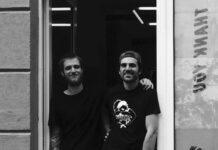Photo: Private (Mark)
„Burial„, the person behind Mark dryly responds to the question who he really is and while that is of course not at all true, the two producers have at least two things in common. First off, there is the anonymity, and secondly, the classic UK rave material they draw their inspiration from. However, while a single search engine will reveal Burial’s identity in a hard beat, you have to dig a little deeper to find out more about the Berlin-based Mark, whose drum’n’bass-inspired releases on A Colourful Storm and, recently, Ostgut Ton’s Unterton sublabel have established him as a force to be reckoned with. The Carla dal Forno affiliate, who also has released music under the alias Klon Dump, sat down for a rare interview with us and recorded a mix for our Groove podcast that shows, in his own words, „the more quote-unquote ‚fun‘ way“ in which he plays at Berghain’s Säule floor or the REEF parties at Berlin’s Griessmuehle.
Here Comes a Fucking Startup Campus, your first EP for the A Colourful Storm label, dealt with the closure of the PostOst artist co-op in Berlin and its closure after the building in which it was hosted was bought up by the, well, start-up campus Factory Berlin. Similarly, the press release for the follow-up Integrier dich, du Yuppie quotes an artnet article on the sale of the city’s Uferstudios. Why is gentrification and its impact on the music scene such an important topic in your work?
It was important because I recorded the EPs at PostOst while Factory was in the process of removing the artists, musicians and craftspeople who’d been working there for many years. To use and greatly benefit from their space in the midst of such a crisis and then walk away without comment felt off to me – doubly so in light of Factory’s extravagantly hypocritical rhetoric, which positions it as a champion and continuation of all that’s good about Berlin’s recent cultural history while fragrantly acting to the contrary.
Your new EP Integriert Euch Nicht was been announced as „something of a spiritual successor“ to Integrier dich, du Yuppie. While the latter title however has an addressee, the former does not. Who is not supposed to integrate themselves – and into what?
I understand the appeal of wanting to unpack a specific argument behind the releases but, to me, the contradictions and ambiguities are crucial to the overall effect. To leave these questions open and to consider the potentials in light of the artwork, track titles and music is more appealing to my tastes than a didactic message. I get that this looks like passing the buck but if I wanted to express a clear point I would’ve written an essay rather than released a record.
The title track features Wilted Woman on aerophone and Silvia Kastel on vocals arranged in the style of serialist Luigi Nono, the other two were recorded live at Berghain. How did the collaboration come about and what did the working process look like?
I transcribed certain vocal passages from quiet sections of pieces like „Y entonces comprendió“ and „La Fabbrica Illuminata“ to get a better understanding of Nono’s clusters and glissandi especially. Once I’d got a sense of it, I used four sine waves to create similar effects. Silvia had learnt extended vocal technique with Joan La Barbara, so I asked if she’d be able to sing each individual sine wave in isolation. She sang the notes one at a time, then I replaced the original sine waves with her voice and manipulated them in various ways. You can hear it most obviously in the section from 4:40 to 5:30. Wilted Woman’s contribution was to replace a sax part with her Roland Aerophone, a somewhat maligned yet underrated instrument that she’s made her own. She makes particularly good use of it in her shows with Silvia as Shakey. You can hear it in the „chorus“ sections such as 2:40.
Your other project is called Klon Dump, so far you have released a single on A Colourful Storm and a tape on Bristol’s NoCorner. What sets the two projects apart?
Making Mark material is a nightmare. Klon Dump is like a holiday in comparison. Another point is that the Mark stuff is relatively cohesive whereas Klon Dump could be anything from goofy mnml to blowing down a cardboard tube.
Under the moniker, you also host a regular show on Berlin’s Cashmere Radio that are stylistically quite diverse. How do you programme these shows?
There’s no specific process apart from listening to a lot of music and looking for connections between pieces. To be fair, the show has somewhat narrowed in scope in the past year. There’s a lot more illbient and drum’n’bass than there used to be.
What was the idea behind your contribution to our Groove podcast?
I get that my music doesn’t necessarily scream functional club DJ so mixes like this are a chance to show the more quote-unquote „fun“ way that I play at Säule, REEF and whatnot. I included a few so-called psybreaks tunes at 33rpm in the middle third, a bit of drum’n’bass at 33rpm, the usual layering and mashups, CDJ business for timing the drops and so on.
Last but not least: Where can we see you behind the decks in the near future and what are your plans as producer?
In the short term, I’m releasing a split with Christoph De Babalon later this year as well as some Klon Dump tracks, both on A Colourful Storm. DJ wise, you can catch me at REEF and Klubacht events.
Stream: Mark – Groove Podcast 206
„No tracklisting but I’ll get in the SoundCloud comments if anyone asks.“





